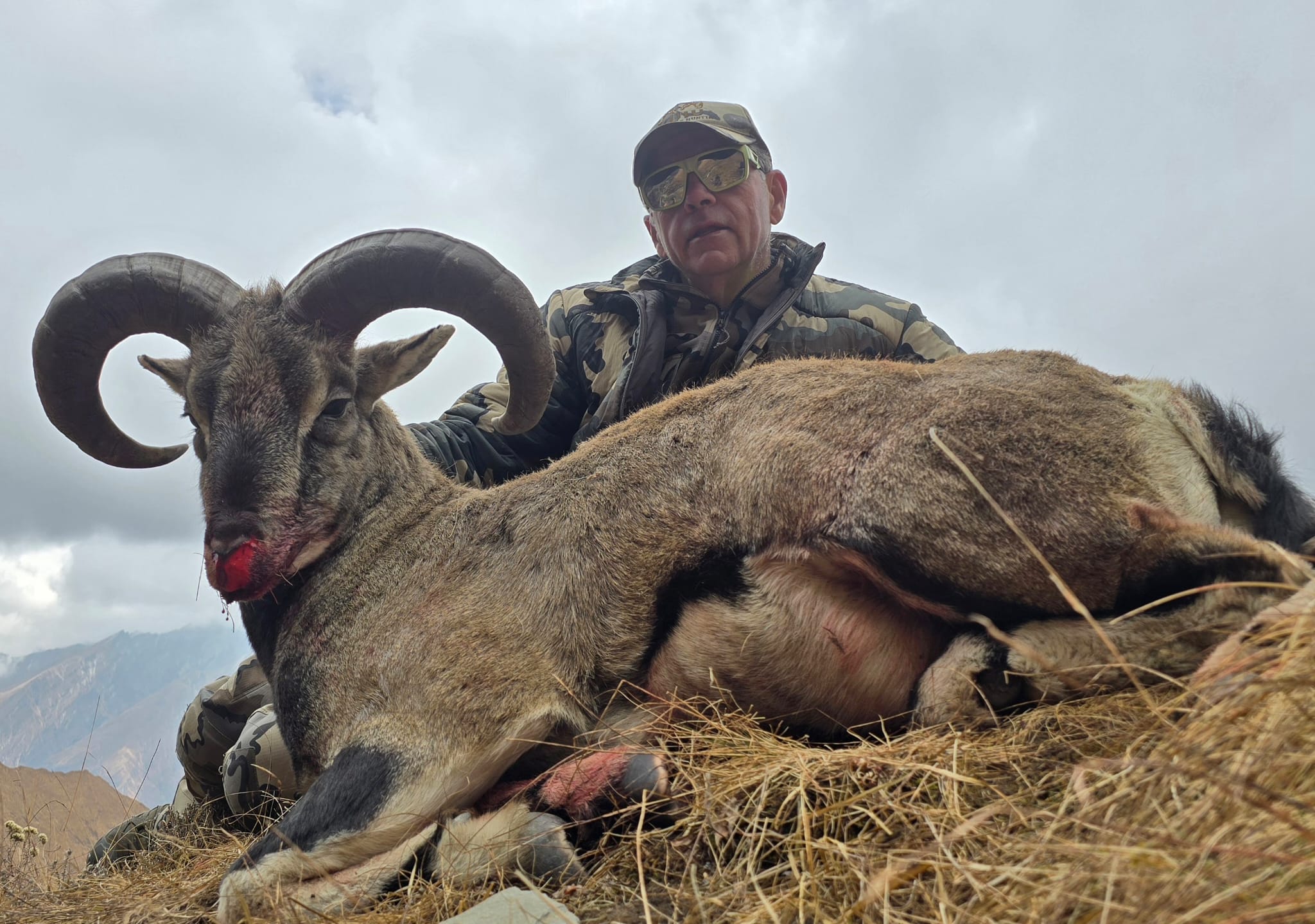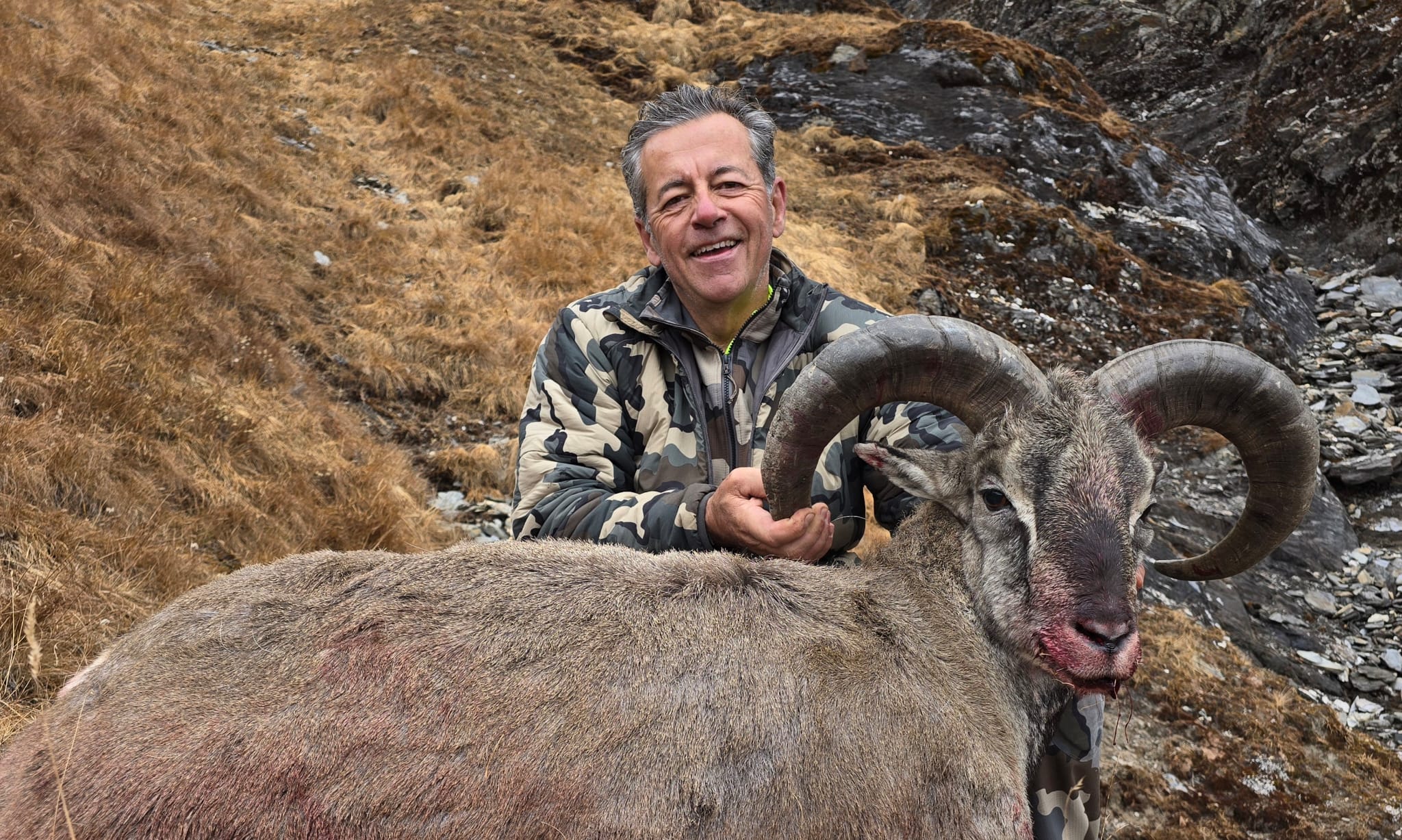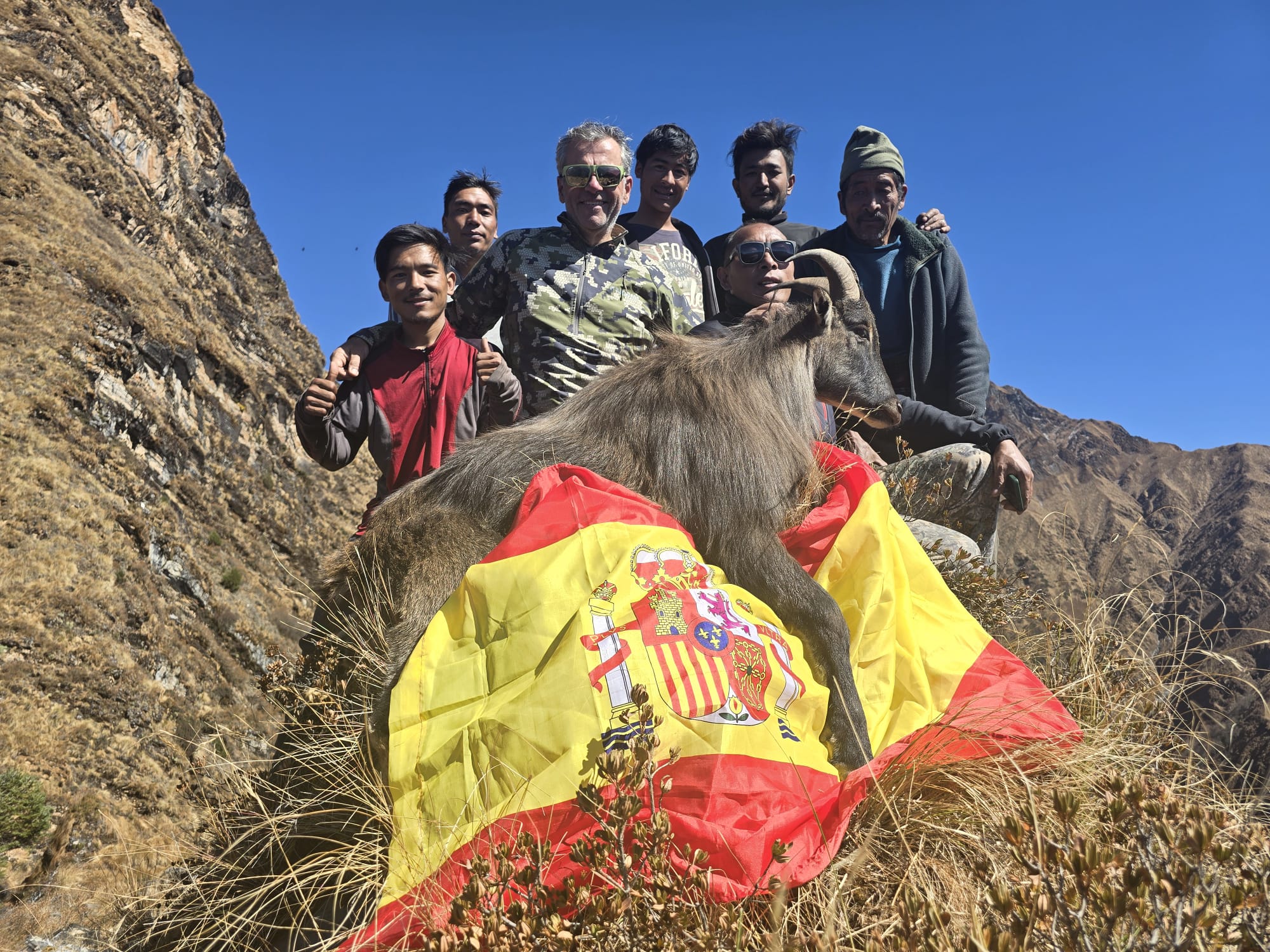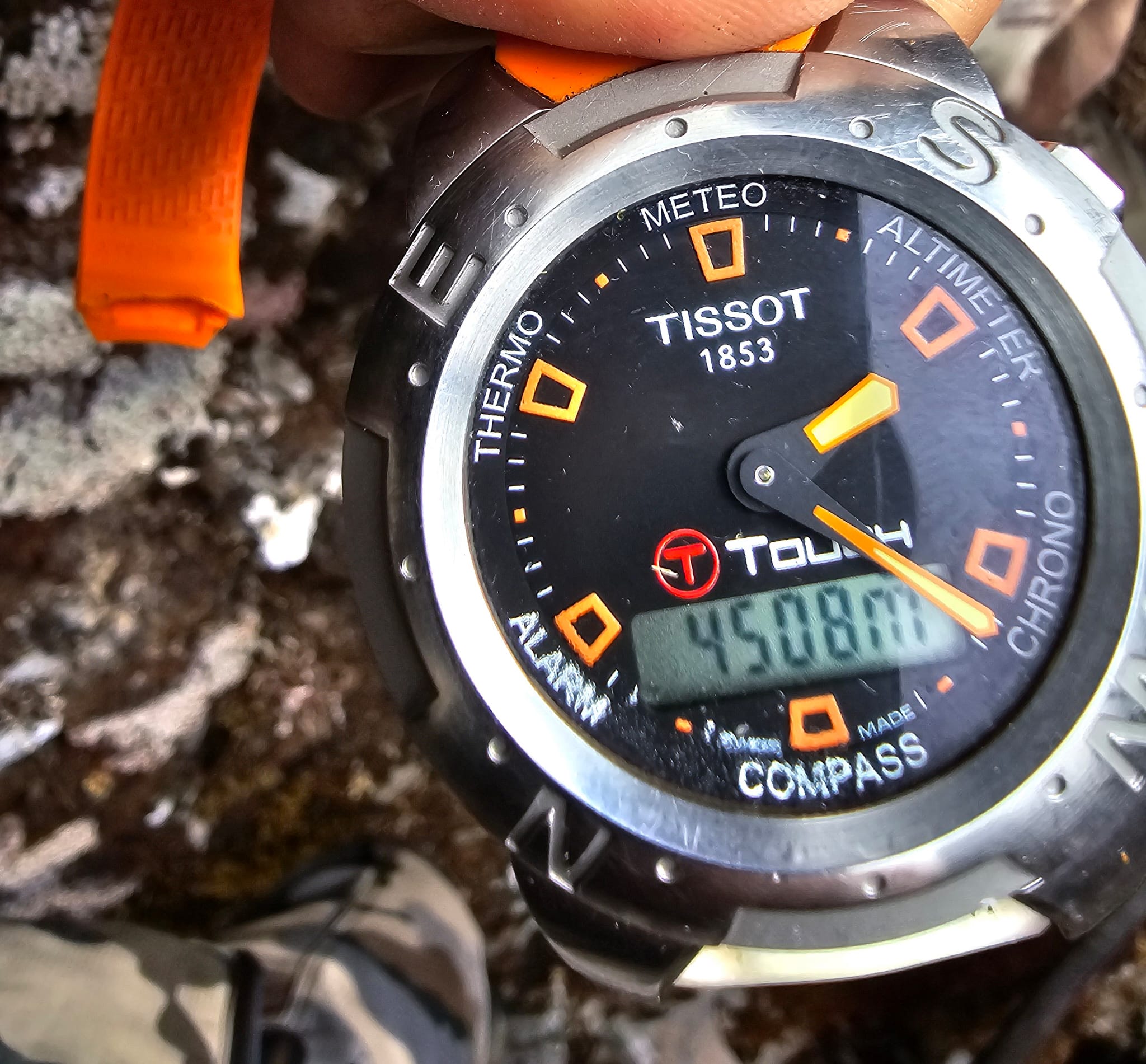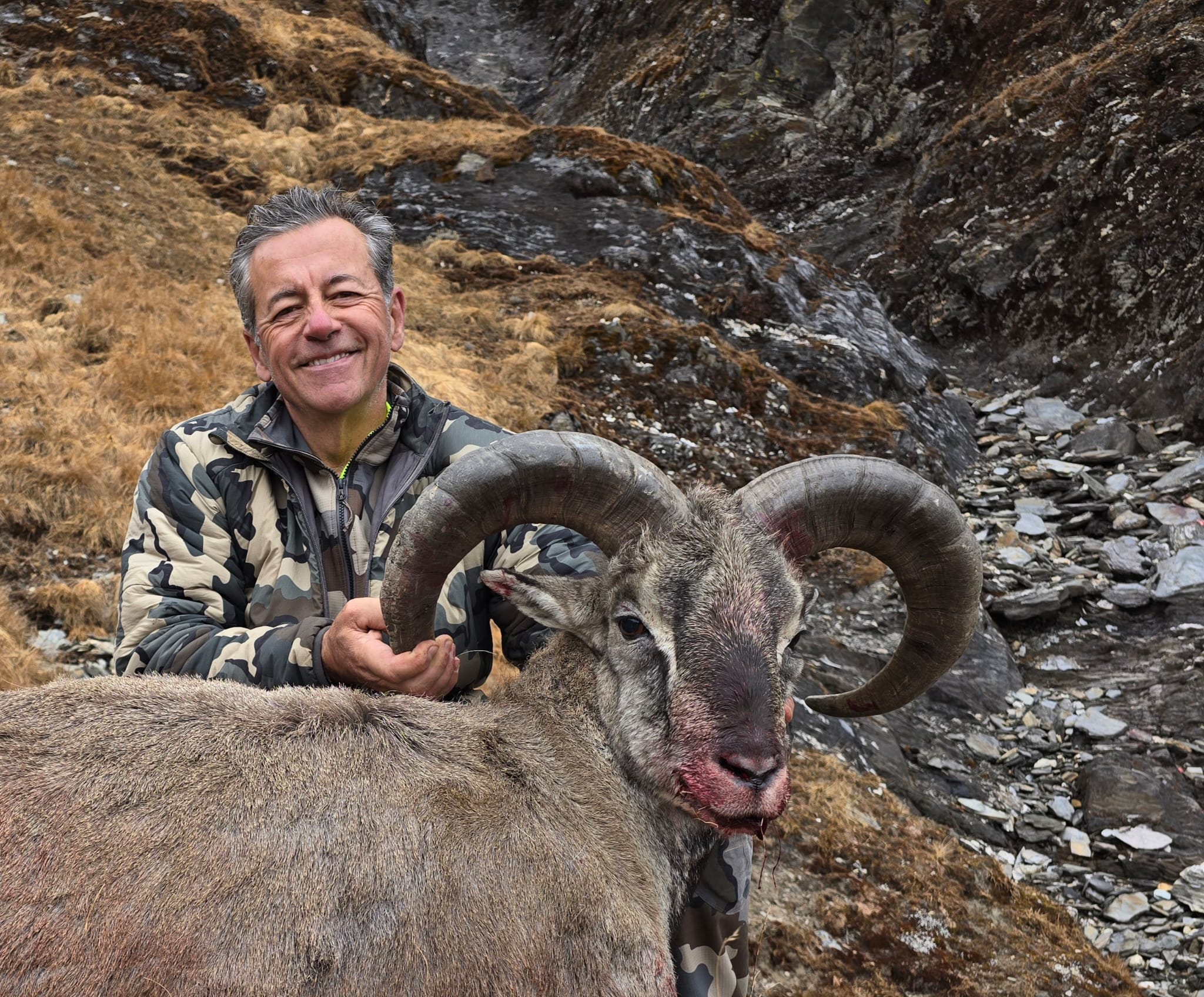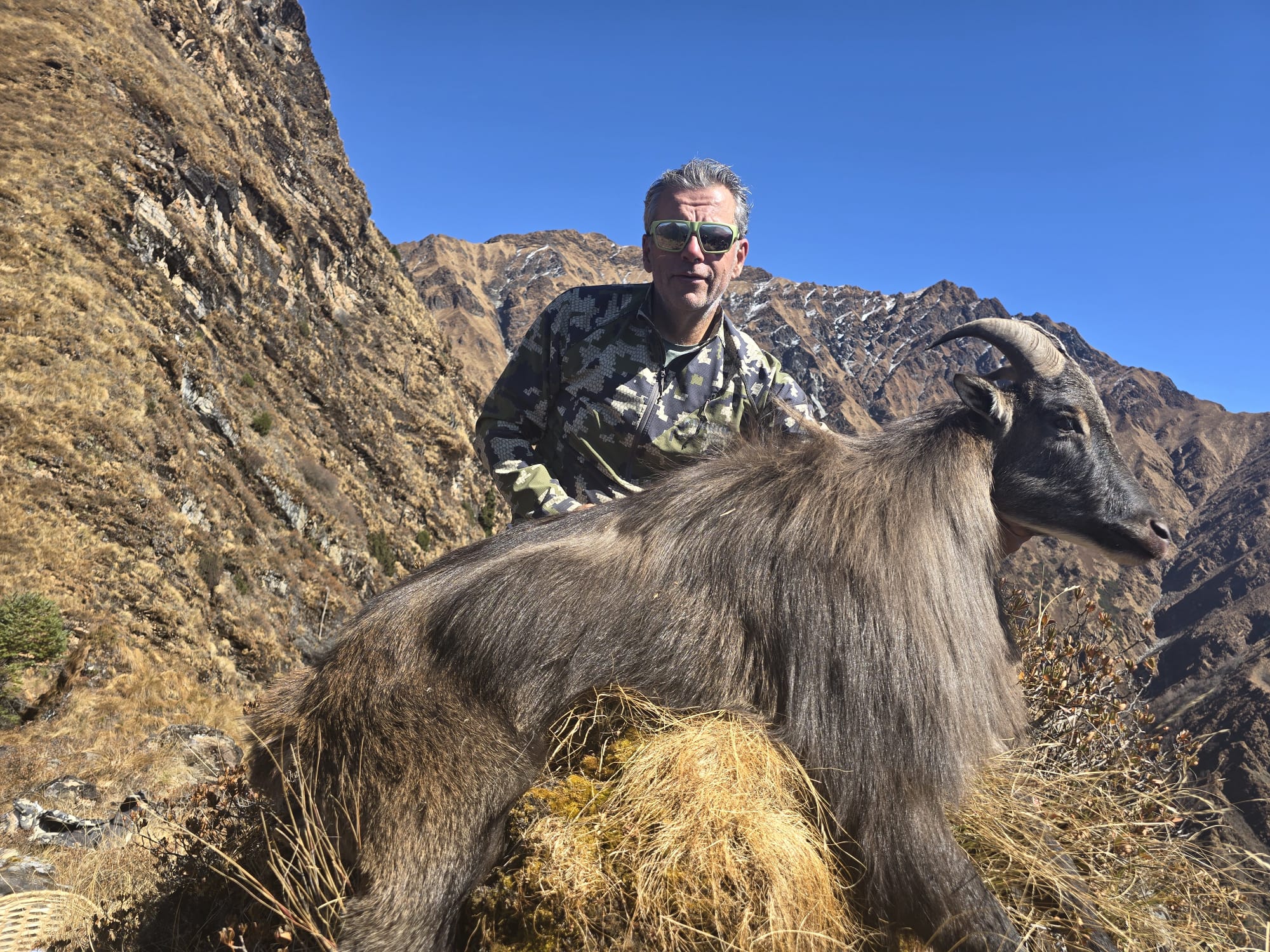
Dhorpatan, the last shikar
Chasing blue sheep and thar in the Himalayas
Mountain Range: Himalayan Range
Area: Gustum
Altitude: 4001 - 4500
Organizer: Open Nepal Wildlife Safari & Trek
Eduardo Martin
Finally, after two years of waiting for a license, the day arrived. Here I am, boarding the plane to Kathmandu with a layover in Istanbul on Turkish Airlines.
We start off with good luck at the airport: when paying the rifle fee, they let me skip the whole line and I check in with no issues.
Arrival in Kathmandu and chaos at the airport: three hours to reach the baggage claim area, but relief when I see the Nepali contact with my rifle and bullets. We wait a bit and finally the suitcase arrives.
I’ll be hunting alongside another hunter, who is accompanied by his outfitter and translator. They take us to a hotel, we have dinner, and go to sleep.
The next day, breakfast and transfer to the airport to catch the helicopter to the Dhorpatan hunting reserve. We run into issues with the helicopter due to weight, and in the end, we fly in two separate trips to avoid problems.
Arrival at the reserve after an exciting flight through valleys and mountains, with some concerns due to low clouds, but we land safely.
The camp was already set up at the same spot where we landed. Upon arrival, some local girls greet us with a flower necklace offering and say prayers, placing rice on our foreheads. We check the rifles, have dinner, and go to bed.
We wake up early and set off towards the next camp, deeper into the reserve. We go from 3200 m (where the helicopter dropped us) to 3800 m. The hike lasts more than 8 hours, up and down, clocking 12,000 steps in 8 hours. Imagine the slope: exhausting. But what’s truly inhuman is watching the poor sherpas carry 30-40 kilos each, plus six mules loaded with gear.
Dinner time arrives, and the other hunter starts getting anxious about hunting together. Apparently, he didn’t know and doesn’t want to hunt at the same time because there could be conflict about who gets to shoot. He urges the outfitter to make separate plans starting the next day.
They ask me to let him hunt the blue sheep we spotted earlier through the scope, and I’ll go after the Thar. I agree, although not gladly, due to the poor manner in which the request was made.
Next day, first hunting day, and we start the ascent in search of the Himalayan Thar through the forested areas—by the way, the vegetation is stunning. During the previous day’s transfer, I enjoyed the Nepali forest, so different from ours, full of rhododendrons (though not in bloom), bamboo, and large holly trees unlike ours, with oak-like trunks and cedar trees that looked like they were made of paper, draped in plant webs that gave off an eerie vibe. Large conifers covered in elegant mosses and lichens brought color to the dark trunks and rocks, creating a harmonious landscape.
We keep climbing without spotting any Thar, but we do locate several groups of blue sheep and decide to pursue one that, from a distance, looks like a great trophy.
Four hours of ascent, reaching 4100 m, and the guide suddenly says we’re not going to make it, that there’s no time. So we head back to camp. Luckily, they had moved it to a higher location by the river at the mountain’s base, saving us one hour of descent and two of ascent.
Despite the physically demanding climbs, I’m loving this hunt. It hasn’t been dangerous so far, as the weather is good and the ground firm, making walking easier. The trekking poles my daughter Roseta and her boyfriend Pablo gave me are proving very useful.
Dinner and to bed—let’s see if tomorrow brings more luck. The Bulgarian didn’t get anything either.
As for the food, it’s as demanding as the hunt: unpalatable. Boiled eggs, boiled potatoes, and dried meat stew, which I skipped today for some plain spaghetti with cheese. Dreaming of food from home.
Still, the experiences are once-in-a-lifetime. So many things stand out. Of course, not everyone could handle it.
Today they were cooking potatoes, and the locals drink the potato-boiling water—hot water with a hint of flavor.
Also noteworthy is the footwear the locals wear in the mountains: sneakers. And they move like gazelles. It’s a bit humbling, although honestly, I feel strong, and aside from a bit of knee pain, I’m doing great. I’m leaving the Bulgarian in the dust—he’s six years younger, but I’m outperforming him.
Second hunting day, fourth day of the trip:
We set off at dawn in search of the Himalayan Thar, since I had let the Bulgarian hunt first. After an hour of climbing, they tell us there are some good blue sheep and we should head toward them. By the time we get there, they had already shot and claimed a pretty good one.
Anyway, we keep hunting and enjoying this wonderful experience.
Up to 4000 m, we walk along goat trails that are physically demanding but not technically difficult. From 4000 to 4500 m, it’s a different story. It’s no longer just physical—it becomes very technical. You have to be extremely focused not to make mistakes and, of course, try to follow the locals’ lead, who in my case are very attentive to me. In skiing terms, you could compare it to off-piste skiing.
We keep climbing and spot several groups but no interesting animals. We reach the summit, 4500 m, and are greeted by a stunning landscape of snow-covered mountains between 6000 and 7000 m. A true privilege to witness and enjoy. I’m in paradise.
We keep hunting and spot a male with a broken horn quite far away and difficult to reach, so we decide to let it go. As evening falls and clouds roll in, obscuring visibility, we decide to return to camp.
The way back was brutal. We had to cross some very tricky spots, and I had my first scare while crossing a cliff—I lost my footing and was left hanging by one arm. It was terrifying. Thankfully, they helped me, because if I had been alone, I could’ve taken a serious fall.
Finally, with little light left, we made it back to camp, exhausted but thrilled by the day.
I washed up, had a bite to eat, and headed to my sleeping bag. Hopefully tomorrow brings better luck.
By the way, the Bulgarian’s trophy: beautiful, a 10-year-old animal, thick and impressive.
Third hunting day:
We woke up at 4:30 a.m., an hour and a half before sunrise. I had leg cramps but hoped they’d go away as I warmed up.
We started with a pre-dawn ascent using headlamps, reaching the first summit in an hour and a half.
The scenery is stunning. Since the night was clear, frost covered all the grass.
We began climbing between two ridges—one white, the other straw-colored—marking our route.
Three hours into the climb, we were nearly at the same spot we left off the day before. Today, the guides seem to be in high gear, moving silently, and they’ve even brought a porter with a meat basket. Promising.
After a while, I see the guides acting differently—they’ve spotted something. They hand me the rifle, and to my surprise, the scope’s turret had shifted to 7 instead of 0. I didn’t know whether to turn it right or left, but I set it to 0. Manaraj points out a blue sheep that’s worth taking, though not a great trophy. At 200 m, I put it in the scope, correct to 200 m, and boom—missed.
I’m crushed after all the effort and excitement for hunting a blue sheep and missing. The guides encourage me to continue and promise more chances.
But I keep obsessing over the turret. During a break, I turn it right—too much range. Then I turn it left and hit the stop. I reset it to 0 manually by rotating a full turn and, using the old-fashioned method, check through the barrel. Seems aligned. I say a Lord’s Prayer and a Hail Mary, and we keep hunting. I couldn’t shoot to test the rifle because we were at the highest point.
We press on, but we can’t climb any higher—we’re at the hunting zone limit of Gustum at 4550 m. Manaraj spots a group of animals, and we observe them for nearly an hour from 500 m away. We can’t move because a female is watching us. These animals are incredibly wild—if they sense anything, they flee.
After an hour, we crawl out of sight and begin the stalk, entering some extremely steep ravines. We get within 150 m. I peek out and the most prominent male is lying down, staring at us. They tell me to wait and shoot when he stands. Imagine missing that shot. He stands up and...
...faces me. They tell me not to shoot yet. He’s staring straight at me, chest fully exposed and steady. I tell myself if I miss, it’s the rifle’s fault. Boom. This time I hit him. He runs and disappears into a ravine. They tell me he’s hit, not to shoot again.
We go down, and he’s still alive. I finish him.
It feels like I’m dreaming. I’m overwhelmed with joy—for everything experienced, the wait for this trip, the effort, the fatigue, the adventure.
The trophy is beautiful—9 years old, very well-formed. Not the one I dreamed of, but it’s mine, the one the mountain gave me. The hunt far exceeded my dreams.
Photos, laughter, a tasty field taco, and return to camp. They say we’ll get there almost at night, a 4-hour trek back—"dear Lord."
The way back is tough, even brutal, crossing dangerous ravines that seem endless. To top it off, it starts hailing—light but annoying.
When we arrive, the whole team is waiting for me with applause and cheers. One by one, they congratulate me. Then it starts hailing hard—we take shelter in the mess tent, and it begins pouring. The poor guys carrying the whole animal on their backs get soaked.
Eventually, everyone arrives. We eat dinner. They tell me I won’t hunt tomorrow and should rest—what a relief. Tomorrow, the Bulgarian hunts the Thar while I rest.
Fourth hunting day: I got up, washed, had breakfast, and went for a walk with my binoculars, looking for a good spot to spend the morning. As often happens, I enjoy the silence, only broken by the continuous sound of water or the occasional crow announcing my presence.
My thoughts drift to Spain, thinking of my family—my wife, daughters, granddaughters, and Edu. A great family that moves me in this amazing setting.
I also recall yesterday’s shot, reliving it in my memory—it’ll be archived there forever.
I return to camp with inner peace, having enjoyed the solitude and silence. I’ll save the effort for another day—I’ve already earned the reward.
We move to the second camp, slightly lower at 3200 m, to continue hunting the Thar the next day.
We wait for the Bulgarian to return from the mountain. Finally, he arrives—exhausted but with a small Thar, happy he didn’t give up. A big storm begins.
A good dinner of macaroni and tuna pizza to recover, and off to bed. It doesn’t stop raining. I barely sleep—can’t breathe well, feeling congested and short of breath. The altitude is tough.
Fifth hunting day: we decide not to hunt due to risk of falling—the rain has made the terrain dangerous.
The Bulgarian gets nervous and decides to return to his country. He convinces the outfitter to head back to the first camp to arrange a helicopter pickup. He leaves, taking half the staff, leaving a tense mood.
Luckily, we have plenty of meat, so we eat meat with potatoes for lunch and dinner. It rains again, and the few of us remaining end the day around the fire.
Sixth hunting day:
Last night was awful—couldn’t sleep, short of breath, very anxious. The altitude is unforgiving, and the closed tent made it worse. I opened the flap and managed to sleep a bit.
We left an hour before sunrise, crossing ravines, streams, and started climbing through dense vegetation. Finally, daylight arrives and we turn off our flashlights.
After three hours, we spot a beautiful male Thar a few kilometers away, his mane blowing in the wind. But going there and back would mean another four-hour climb, so we keep hunting, saving that one for tomorrow.
An hour later, Manaraj’s son, who had climbed a peak, signals us to come. We climb—on all fours—to the top, helped by Manaraj’s uncle, who must be around eighty. Later they told me he’s just four years older than me. Slowly, crawling, we reach the summit in an hour.
They tell me there’s a large male with females and a small one in a ravine below, about 120 m down. I peer over the edge and see a female and her young but not the male. I scan with binoculars and finally see him in the worst possible position—completely vertical.
I place him in the crosshairs, shoot, and it’s a clean hit. Hugs, kisses, and we wait for reinforcements to retrieve the animal from the ravine.
He’s gorgeous—a farewell gift from the mountain. A 14-15-year-old animal. A wonder.
Photos and hugs with everyone. They say I’m very lucky—and I believe them. I’ve fulfilled a dream, the dream of a lifetime.
This has been the most demanding and beautiful hunt I’ve ever done.
Back to camp, and tomorrow we’ll head to the first camp—another tough hike, seven hours. From there, the helicopter will pick us up for Kathmandu. When we get there, the Bulgarians are still waiting—they couldn’t get to Kathmandu due to lack of helicopters. Tomorrow, one will finally come, though it will take us to an intermediate city, not Kathmandu. There, we’ll catch a flight to Kathmandu. I’ll try to change my tickets and go home to my family, whom I’m so eager to see.
Report Gallery
